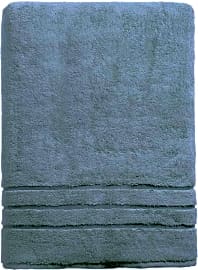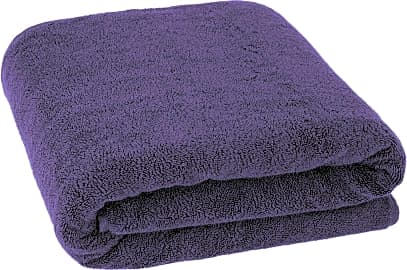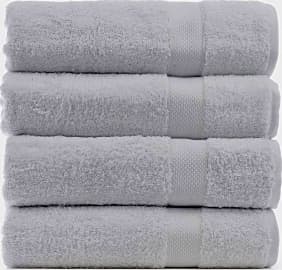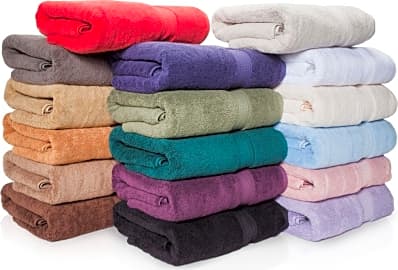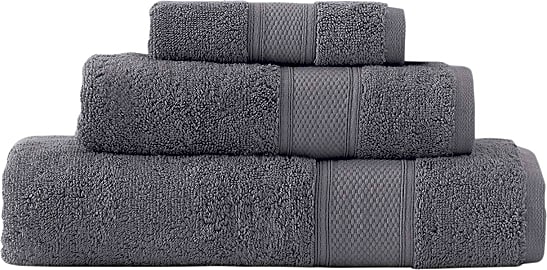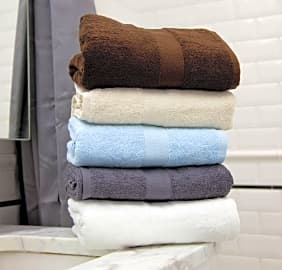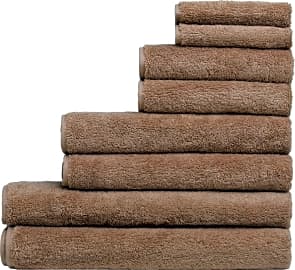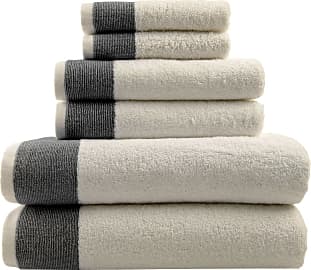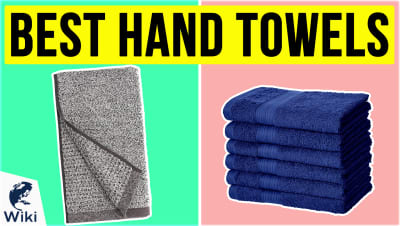The 10 Best Bath Towels

This wiki has been updated 39 times since it was first published in March of 2015. Unfortunately, many bath towels are made with low-quality materials that fall apart quickly and lose their absorbency, and they're often not very soft, to boot. Not to worry, however, as we've managed to find plenty of top-notch choices that truly stand out from the rest. Whether you want a budget set for a big household or a high-end treat for yourself, we've got you covered — literally. When users buy our independently chosen editorial recommendations, we may earn commissions to help fund the Wiki.
Editor's Notes
December 09, 2020:
We are happy to replace the Texere Jacquard with the Onsen Lightweight, since the latter offers an interesting texture just as the Texere model does, but soaks up water better. But keep in mind that not everyone will enjoy the Onsen's texture, which makes this towel feel a bit like a blanket. This means it can't give you that super plush, fluffy experience that standard towels can, a definite deal-breaker for some. On the other hand, the elegant appearance, fast drying time, and handsome colors will definitely make this a go-to for others.
When it comes to models with a standard feel, we've kept the popular Towel Bazaar Multipurpose, Cariloha Bamboo, and Chakir Hotel & Spa as strong choices. We've also selected the Cotton Paradise Luxury, a jumbo bath sheet that comes in plenty of colors, such as a cheery yellow, and that offers matching accessories, including a mat. This ensures it's a good choice for those who are redoing their whole bathroom, but not in standard muted neutrals. For a bold look, you might also consider the Lunasidus Venice, which has a colorblock pattern.
May 17, 2019:
At this time, we have decided to remove the Utopia 700 GSM due to problems with lint shedding, which is both annoying and potentially hazardous, as it causes fluffy buildup in a dryer. But we still find the Cariloha Bamboo and Magic Baby Organic Muslin to be top choices. Note that the Cariloha is usually sold singly and not in sets, which makes it a rather expensive option; nevertheless, it's an investment in quality that will last. We've also added the Towel Bazaar Multipurpose as a more budget-friendly, but still high-quality, option. It comes in bright as well as neutral colors and ticks all the boxes: absorbent, comfortable, sizable. The Home & Plan 8-piece set is another option that's modestly priced, although some dislike the fact that you must purchase an entire set. If you need only one washcloth or bath towel as a replacement, you may just be out of luck. Finally, we still like the Texere Jacquard, but it's worth noting this choice isn't as absorbent as some. It's extremely eye-catching, though, so you might consider them as decorative towels in a guest bathroom.
Special Honors
The Ritz-Carlton Shops When nothing less than the absolute gold standard in luxury will do, you might opt for a bath towel set from The Ritz-Carlton Shops. True, they'll put the squeeze on your wallet, but the touch of class they'll add to your ablutions is worth it. ritzcarltonshops.com
Frontgate Resort Cotton Bath Sheet There are few options longer than the Frontgate Resort Cotton Bath Sheet, which measures an impressive 72 inches long — that's 6 feet. They're luxurious and durable and surprisingly inexpensive for the quality, but you'll need to avoid getting toothpaste and cleansers on them, as these can cause discoloration. frontgate.com
Brooklinen Super-Plush Thanks to their 820 GSM construction, the Brooklinen Super-Plush are able to live up to their name, making this just the ticket to help you turn your boring bathroom into a sumptuous spa. They don't come in as many colors as some others, but the available choices include plenty of handsome neutrals. brooklinen.com
How To Choose the Right Bath Towel
While these towels will be the most absorbent, they will also take the longest to dry.
Choosing the right bath towel can be tough. What makes one bath towel different from another? To help you understand the nuance of these distinctions, we've written a guide on how to choose the right bath towel.
One metric used for comparing towels is the grams per square meter number. The GSM measures a towel's density, such that towels with lower GSM are less dense, thinner, and lighter, while towels with higher GSM are denser, thicker, and heavier.
Typically, the higher the GSM, the more absorbent the towel. Low GSM towels—think between 300-400 GSM—may be well-suited for traveling or bringing to the gym. Medium GSM towels between 400-600 GSM serve as great guest towels or beach towels. And at the top of the GSM spectrum, high GSM towels between 600-900 GSM are usually those luxurious, lush towels used at resorts. While these towels will be the most absorbent, they will also take the longest to dry.
One of the most important factors to consider when buying a bath towel is its material. Different materials all have unique influences on a towel's absorbency, durability, and how long the towel will take to dry. Most bath towels are made from cotton because it is a highly absorbent and strong material. While many standard bath towels are made from plain cotton, also known as American upland cotton, bath towels can also be made from Egyptian, Pima, or Turkish cotton.
When a label only says 100 percent cotton, the product was probably made using American upland cotton. The differences between all of these cotton varietals primarily lies in the fiber's staple length, strength, absorbency, and fineness. Upland cotton tends to have a shorter staple length than Egyptian, Pima, and Turkish cotton, which all have longer staple lengths.
Egyptian and Pima cotton are both considered ELS (extra-long staple) cottons. This means that their fibers are extra long, making these cotton varietals supremely absorbent and soft. Egyptian and Pima cotton fibers are also particularly thin, making for a high density or high GSM towel.
The most luxurious towels are usually made with either Egyptian or Pima cotton, such as those used in high end resorts. Egyptian ELS cotton is usually considered slightly superior to Pima cotton, though these days most Egyptian cotton is only long-staple cotton that merely comes from Egypt.
To identify authentic Egyptian ELS cotton, look for a small black triangle containing a picture of cotton. Pima is the American-grown version of Egyptian ELS cotton, but is sometimes mixed with other cottons of a lower quality. To ensure that you get a product made with high-quality Pima cotton, look for products with a Supima cotton label, as this label guarantees 100 percent America Pima cotton.
While Egyptian and Pima cotton towels are luxurious and highly absorbent, their absorbency and high density does mean they take longer to dry. This makes the towel more prone to mildew and mustiness. If you live in a humid environment, you may want to avoid Egyptian and Pima cotton towels and instead opt for Turkish cotton towels.
Turkish cotton is a long staple fiber rather than an extra-long staple fiber, making it slightly less absorbent than Egyptian or Pima cotton. That said, there are numerous benefits to choosing a Turkish cotton bath towel, as its slightly shorter fibers will dry much more quickly and prevent mildew. This makes it a very good option for those who live in humid environments. As an added bonus, Turkish towels will become both softer and more absorbent with each wash.
For an even faster-drying towel, you could try a microfiber towel, but it will lack the lush feeling that you'd encounter with either Egyptian, Pima, or Turkish cotton.
The texture and feel of a bath towel is affected by the construction of its yarn, or the way in which the fibers are turned into yarn. While there are several different construction techniques, bath towels are typically made with either combed, ring-spun, or twisted fiber.
Combed cotton is made using a technique in which a fine brush removes impurities and uneven, short fibers. This leaves behind longer fibers that form a stronger and softer cotton. Combed cotton is also resistant to pilling.
Ringspun cotton is made with both long and short staple fibers that have been twisted together, forming an even smoother, stronger, and finer yarn. Ringspun cotton is a step-up from combed cotton.
Twisted cotton is cotton that has been twisted, and the twist is a measurement of twists per inch of yarn. Low twist fabric is the most plush, and requires longer staple cotton. High twist fabric is less plush, but stronger and more uniform, ultimately making a more durable towel.
A towel's pile refers to the loops that comprise the surface of the material. Towels can have either single or double loop pile. Single loop towels are less dense and will dry more quickly. Double loop towels are denser and tend to feel more plush, but also take longer to dry. The pile can also be cut or uncut. Generally, cut fibers are softer but slightly less absorbent, while uncut fibers maintain the loops that allow the material to be more absorbent.
Towel Washing and Maintenance Tips
If you think washing your towel once a week or around every seven uses is often enough, think again. You should wash your towel at least every three uses. I know this isn't the news you want to hear, but your bath towel is gross! Your towel needs to be washed at least once every three uses because it accrues all sorts of unpleasant stuff with each use.
When you dry off with your towel, you transfer dead skin cells as well as any salivary, anal, and urinary secretions from your body. Of course, that's not to mention any of the other bathroom bacteria that hops on while your towel is in the bathroom.
Because your towel's job is to absorb moisture, it spends a lot of time being moist, and thus becomes an ideal environment for the propagation of bacteria. Bacteria thrives in moist environments, and the same type of mildew that accumulates on your plastic shower curtain will accumulate on your towel, too.
Chlorine bleach is hard on cotton fibers, and can cause the towel's fibers to weaken and break.
Believe it or not, that musty smell that unwashed towels eventually get is literally the odor caused by breeding bacteria. This is why it's so important to let your towel dry out completely between uses—if your towel does not dry out completely between uses, it should be washed even more often than once every three uses.
Of course, there are other circumstances in which your bath towel should be washed after each use. People with fungal infections such as athlete's foot, jock itch, or ringworm, and those with bacterial infections like styes should wash their towel after each use to avoid reintroducing the microorganism or bacteria to the body.
Since you're going to be washing your bath towel more often now (I hope), it's important that you follow proper washing instructions to keep your towel looking good for as long as possible. Follow these tips when washing your towel:
Wash your towels before using them for the first time. Washing your towels before their first use makes them more absorbent, helps to set the colors, and reduces lint. For the first wash, add 1/2-1 cup of white vinegar to the washing machine. Repeat this about once every three washes.
Vinegar is great for setting colors and keeping towels white, as well as for helping fight off that musty smell that towels are prone to getting. Vinegar also combats residue left behind from hard water and chemical buildup from laundry detergent.
Avoid using fabric softener on your towels. Over time, using fabric softener on your towels can leave a waxy residue that breaks down the towel's fibers and decreases the towel's absorbency. Also, avoid using chlorine bleach on your towels. Chlorine bleach is hard on cotton fibers, and can cause the towel's fibers to weaken and break. Bleach can also cause yellowing in your towels.
Don't let your towels come into contact with skin care products containing benzoyl peroxide. This will bleach and lighten spots on your towel. Similarly, you may also want to avoid letting your towel come into contact with cosmetics or household cleaning products that could leave unsightly stains.
Wash towels with other towels. Washing towels together, separately from clothing, is good for both sanitary reasons and for avoiding pilling. The shorter fibers used in clothing can cause unnecessary pilling when they rub against towels' longer fibers. Additionally, washing towels separately helps avoid discoloration caused by contact with colored fabric that may take place over repeated washes.
Make sure your towels are completely dry before storing them. If towels are put away while damp, they are prone to mildew growth and mold. That said, it's also important to avoid over-drying your towels, which can lead to the deterioration of the towel's fibers.
A Brief History of the Towel
The first bath towels originated in Bursa, Turkey, during the 17th century, in association with Turkish baths called hammams. Dating back to the Ottoman Empire, hammams played an intimate role in Turkish life, and served not only as places of cleanliness, but also had ceremonial and social functions.
They were designed to be wrapped around the bride's torso, and were typically fringed on both ends.
The earliest Turkish towels, called pestemals, originated with one of these ceremonial rituals, that being a bride's prenuptial bath at the hammam. As part of the ceremony, an elaborately embroidered set of pestemals—one for each hip, shoulders, and head—were used during the bride's bath. They were designed to be wrapped around the bride's torso, and were typically fringed on both ends.
Later, pestemals became more commonly used at the hammam. They consisted of flat, woven sheets of either cotton or linen, sometimes embroidered, and were much narrower than today's bath towels. Pestemals absorbed water quickly whilst remaining lightweight, and also dried quickly, making them ideal for use at the hammam.
The Ottoman Empire's growth placed new demands on the towels, requiring increasingly elaborate designs. By the 18th century, towels featured more intricate designs—aided by extensive knowledge of carpet design—and were made with loops, similar to today's towels.
These looped towels were referred to as havly, today called havlu, meaning "with loops" in Turkish. The loops were created by hand using two strands of thread, such that one thread formed the towel's base while the other formed the loop. This is called a fabric's ply.
While these towels were not originally affordable for most, they became more affordable when the 19th century brought industrialization to the cotton trade. The mechanization of fabric manufacturing made it possible to sell cotton terry toweling by the yard, and pre-made towels finally hit stores.


